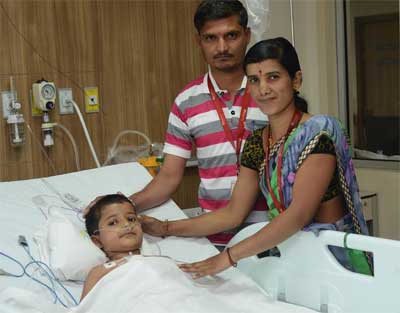- Home
- Editorial
- News
- Practice Guidelines
- Anesthesiology Guidelines
- Cancer Guidelines
- Cardiac Sciences Guidelines
- Critical Care Guidelines
- Dentistry Guidelines
- Dermatology Guidelines
- Diabetes and Endo Guidelines
- Diagnostics Guidelines
- ENT Guidelines
- Featured Practice Guidelines
- Gastroenterology Guidelines
- Geriatrics Guidelines
- Medicine Guidelines
- Nephrology Guidelines
- Neurosciences Guidelines
- Obs and Gynae Guidelines
- Ophthalmology Guidelines
- Orthopaedics Guidelines
- Paediatrics Guidelines
- Psychiatry Guidelines
- Pulmonology Guidelines
- Radiology Guidelines
- Surgery Guidelines
- Urology Guidelines
6-year-old with critical heart ailment saved after surgery at HN Reliance Foundation Hospital

Mumbai : Sanket More, a six-year-old boy hailing from a farmer’s family in Aurangabad, was referred to Sir H N Reliance Foundation Hospital and Research Centre by a noted Paediatric Cardiologist from Pune, Dr Pankaj Sugaonkar. The child was diagnosed with a complex heart defect, wherein all the heart chambers and arteries were interchanged. There was a large hole in the heart, and the artery to the lungs was narrow, resulting in extremely poor supply of impure blood to the lungs for purification. To make matters worse, the heart was located in the right side of the chest instead of left, and the coronary arterial courses were too crowded for an area to be chosen to connect the heart and lungs with the interposition conduits.
After an initial clinical evaluation, the child underwent a detailed echocardiography to confirm the findings, as well as to chart the surgical path for correction. There were three choices for the team of attending doctors:
- A simple surgery of diverting the entire oxygen-poor blood directly into the lung arteries that would provide a limited life span of inferior quality.
- Plugging the hole in the heart, and putting an artificial tube from the left chamber to the tube carrying the blood to the lungs – an option in which a sub-optimal pump is assigned to pump blood.
- A highly complex repair that will make the natural pumping chamber the main pump of the heart, and provide a near normal quality and longevity of life.
In addition, the chance of producing a heart block – a problem where one needs to insert a pacemaker to correct the heart rate – is high due to the inherent nature of the problem. In Sanket’s case, a surgeon would have had to be extremely careful while trying to plug the hole in his heart, so as to not trigger the above problem.
After much deliberation, the team comprising a cardiologist, cardiac surgeon, anaesthetist and an intensivist decided to undertake the complex repair. It was also decided to work up the patient so that a Plan B could be implemented if Plan A fails.
A cardiac catheterisation test was performed to assess the pressures in the lung arteries, and to be ready for a second surgery if the need be. The surgical team discussed and planned all the steps of the complex repair – right from opening the chest till closing it.
Things went like clock-work in the operation theatre. It helped in reducing the operation time, as well as the time required to use the bypass machine while the heart was being repaired. The overall reduction in time meant less injury to the lungs and the heart. As a result of this meticulous planning and execution, the child could be taken off the ventilator the very next day after the surgery. His blood pressure medication too ran for a short while. The child is now taking food orally, and has been mobilised in the ICU.
Dr Shreepal Jain, Senior Paediatric Cardiologist of the hospital, said, “This case highlights the importance of team work, meticulous planning and perfect execution in the entire peri-operative period. Very few hospitals in the country have the kind of surgical expertise and infrastructure required to carry out such a complex surgery on a kid. By undertaking this route, we have provided Sanket with a near normal heart and a superior quality of life.”

Disclaimer: This site is primarily intended for healthcare professionals. Any content/information on this website does not replace the advice of medical and/or health professionals and should not be construed as medical/diagnostic advice/endorsement or prescription. Use of this site is subject to our terms of use, privacy policy, advertisement policy. © 2020 Minerva Medical Treatment Pvt Ltd